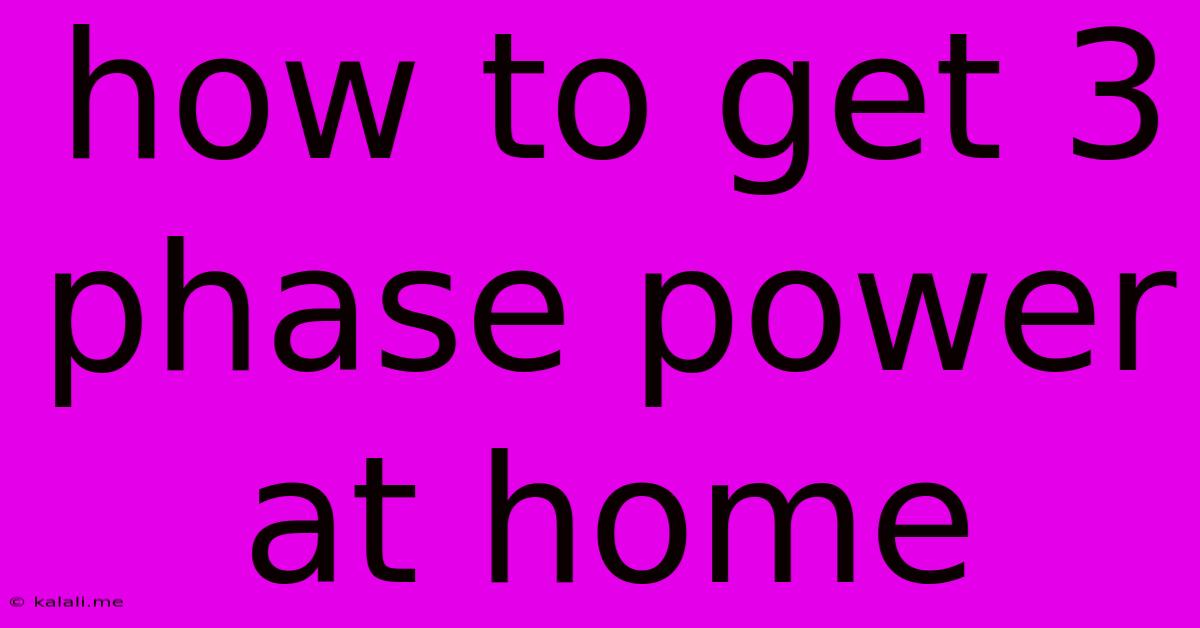How To Get 3 Phase Power At Home
Kalali
May 21, 2025 · 3 min read

Table of Contents
How to Get 3-Phase Power at Home: A Comprehensive Guide
Getting 3-phase power for your home might seem daunting, but understanding the process can make it manageable. This guide breaks down the steps involved, helping you navigate the complexities and ultimately decide if it's the right choice for your needs. This article covers the reasons you might need it, the process of application, and important considerations to keep in mind.
Why Might You Need 3-Phase Power at Home?
While most homes operate on single-phase power, there are specific situations where 3-phase power becomes essential. These typically involve high-power appliances or equipment demanding significantly more energy than a single-phase system can handle. Consider these scenarios:
-
High-power machinery: Workshops, home-based businesses, or hobbyists with high-power tools (like large welders, industrial 3D printers, or CNC machines) often require the higher capacity of a 3-phase system. Single-phase circuits might struggle to provide sufficient power, leading to voltage drops and potential damage to equipment.
-
Electric vehicle charging: While many EV chargers operate on single-phase, high-power fast chargers often require 3-phase power for quicker and more efficient charging. This is particularly relevant for those with multiple EVs or large battery capacities.
-
Large HVAC systems: Homes with extensive HVAC needs, such as large mansions or those in extreme climates, might benefit from 3-phase power to support powerful air conditioning or heating units.
-
Specialized equipment: Certain home-based businesses or specialized equipment may have specific power requirements necessitating a 3-phase supply. This could include server rooms, specialized manufacturing equipment, or large water pumps.
The Process of Getting 3-Phase Power:
The process of obtaining 3-phase power varies depending on your location and the local utility provider. Generally, it involves these steps:
1. Assessment and Planning:
-
Determine your power needs: Accurately calculate the total power demand of all your 3-phase appliances and equipment. This is crucial for specifying the correct service capacity to your utility company. Consult with an electrician for professional assessment.
-
Check feasibility: Contact your local electricity provider to determine the feasibility of installing 3-phase power at your location. They’ll assess your property’s infrastructure and the availability of a 3-phase supply in your area.
2. Application and Permits:
-
Submit an application: Your utility provider will have a formal application process that requires details about your power needs, equipment specifications, and planned usage.
-
Obtain necessary permits: Depending on your location and the scale of the installation, you’ll likely need permits from your local building authority. This ensures compliance with electrical codes and safety regulations.
3. Installation and Connection:
-
Professional installation: The installation of 3-phase power requires the expertise of a qualified electrician. Attempting DIY installation can be extremely dangerous and may void any warranties or insurance coverage.
-
Inspection and approval: Once the installation is complete, a qualified inspector will verify the work complies with all relevant codes and regulations before the connection to the 3-phase supply can be finalized.
Important Considerations:
-
Cost: Installing 3-phase power is significantly more expensive than a standard single-phase system. The costs include application fees, permit fees, equipment upgrades, and the electrician's labor.
-
Safety: Working with 3-phase power is inherently more dangerous than single-phase power. Professional installation and adherence to safety regulations are paramount.
-
Long-term planning: Consider your future power needs to ensure the installed capacity is sufficient for any potential expansions or changes in equipment.
Conclusion:
Obtaining 3-phase power for your home involves a multifaceted process that requires careful planning, professional expertise, and adherence to safety regulations. While it offers significant advantages for high-power applications, it's crucial to weigh the costs and complexities against your specific needs before embarking on this endeavor. Always consult with qualified electricians and your utility provider throughout the entire process.
Latest Posts
Latest Posts
-
Can Solar Panels Work Through Glass
May 21, 2025
-
Car Loses Power Then Comes Back
May 21, 2025
-
How To Put Out An Incense Stick
May 21, 2025
-
How To Breed Polar Bears Minecraft
May 21, 2025
-
Do You Have To Primer A Wall Before Painting
May 21, 2025
Related Post
Thank you for visiting our website which covers about How To Get 3 Phase Power At Home . We hope the information provided has been useful to you. Feel free to contact us if you have any questions or need further assistance. See you next time and don't miss to bookmark.